

Site dedicated to the taxonomy of Ascomycota. Vanderbilt University. A bird’s beak or a whale’s flipper contains information not only its function but also about its history.
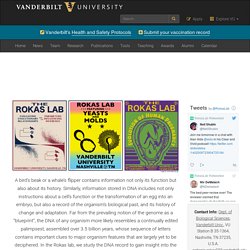
Similarly, information stored in DNA includes not only instructions about a cell’s function or the transformation of an egg into an embryo, but also a record of the organism’s biological past, and its history of change and adaptation. Far from the prevailing notion of the genome as a “blueprint”, the DNA of any organism more likely resembles a continually edited palimpsest, assembled over 3.5 billion years, whose sequence of letters contains important clues to major organism features that are largely yet to be deciphered.
In the Rokas lab, we study the DNA record to gain insight into the patterns and processes of evolution, focusing on three major questions: Partial mycoheterotrophs: The green plants that feed on fungi. You probably learned this basic lesson of biology in elementary school: Plants are self-feeders.

These so-called autotrophs use the sun’s energy and water to turn carbon dioxide from the air into food through the process known as photosynthesis. Autotrophic organisms sit at the base of every food chain on Earth and sustain all levels of life as we know it. But competition among plants for resources like water, light and nutrients can be intense. Stinkhorns, truffles, smuts: The amazing diversity – and possible decline – of mushrooms and other fungi.
“Whatever dressing one gives to mushrooms…they are not really good but to be sent back to the dungheap where they are born.”

French philosopher Denis Diderot thus dismissed mushrooms in 1751 in his “Encyclopedie.” Today his words would be dismissed in France, where cooks tuck mushrooms into crepes, puff pastry and boeuf Bourguignon (beef Burgundy), to name just a few dishes. The French aren’t alone. Mushrooms and their biological relatives feature in global cuisines from Asia to sub-Saharan Africa. Mushroom.
Terms discussed: fleshy fungus (pl. fleshy fungi), Fungus (pl.
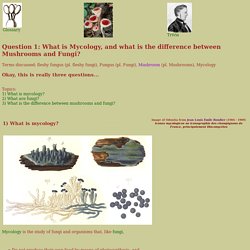
Fungi), Mushroom (pl. Mushrooms), Mycology Okay, this is really three questions... Topics:1) What is mycology? 2) What are fungi? 19 Things I Learned on a Mushroom Walk. There's an old saying among botanists: If you take a walk in the woods with a botanist, you'll never get where you're going.
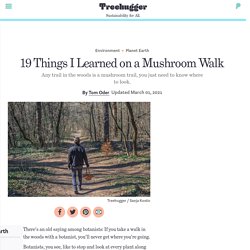
Botanists, you see, like to stop and look at every plant along the way. The same could be said for a walk with a mushroom expert. Wild Mushrooms: What to Eat, What to Avoid. Mushroom collecting is one of the most widespread activities in a movement to discover local sources for food that is growing in popularity nationwide.

For people who enjoy foraging for food in the wild, there are plenty of mushrooms to choose from — several thousand fleshy species in North America. Of these many different kinds of mushrooms, almost all are “edible” but too fibrous or insignificant to consume. That still leaves a considerable portion of mushrooms as consumable and either "fair, good, or choice. " While the numbers vary and are debatable, only about 250 are considered significantly poisonous. 14 Gorgeous Mushrooms That Show Fungi's Glamorous Side. Mushrooms are all too often relegated to the realm of dark and funky fungi, when in fact many are worthy of super-swooning.
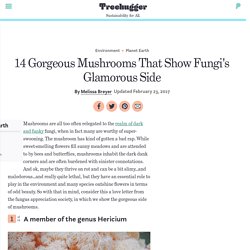
The mushroom has kind of gotten a bad rap. While sweet-smelling flowers fill sunny meadows and are attended to by bees and butterflies, mushrooms inhabit the dark dank corners and are often burdened with sinister connotations. And ok, maybe they thrive on rot and can be a bit slimy...and malodorous...and really quite lethal, but they have an essential role to play in the environment and many species outshine flowers in terms of odd beauty. So with that in mind, consider this a love letter from the fungus appreciation society, in which we show the gorgeous side of mushrooms. 14 Bizarre and Beautiful Mushrooms. Fungi date back at least half a billion years or so, and a few fungus-like fossils seem to be even more ancient.
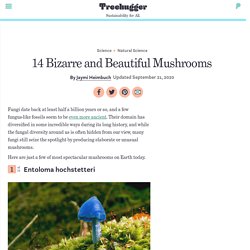
Their domain has diversified in some incredible ways during its long history, and while the fungal diversity around us is often hidden from our view, many fungi still seize the spotlight by producing elaborate or unusual mushrooms. Here are just a few of most spectacular mushrooms on Earth today. Entoloma hochstetteri Found in New Zealand and India, this tiny mushroom is easily recognized by its vivid blue color, which comes from three azulene pigments. 11 Colorful Fungi That Look Like They Came From Willy Wonka. The fungi kingdom has an amazing diversity.
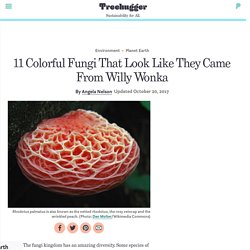
Some species of fungi are responsible for the creation of life-saving drugs such as penicillin and other antibiotics. Others are responsible for making dishes such as risotto or chicken Marsala more tasty — and healthy, too. (Mushrooms have a host of surprising health benefits). Bioluminescent Fungi: 12 Mushrooms That Glow in the Dark. Out of this world Of all the wild and wonderful things to find in the wilderness, mushrooms are by far the most bizarre.
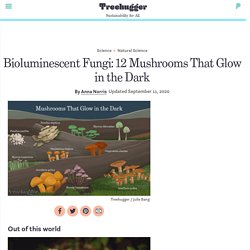
They sprout up in wooded areas throughout the world, adding a fantastical element with their strange appearance. They will catch your attention in the daytime – but wait until you see these fungi at night. There's even a name for the mysterious glow from mushrooms: foxfire. Scientists have hypothesized that the bright bluish-green light is meant to attract insects. 13 Bizarre Mushrooms. With about 14,000 described mushrooms currently inhabiting dank forest floors, decaying tree trunks, and dung piles, there are bound to be some strange-looking varieties. Some depart entirely from the toadstool silhouette—the stereotypical rounded-cap-atop-a-stem set—with lengthy hairlike spines, fanning shell shapes, flower-esque pedals, and lattice designs. Others that lack uniqueness in shape are fantastic in their royal blue, indigo, and even bioluminescent colors. Many of the most bizarre mushrooms on the planet are extremely elusive. Some are poisonous, some not. British Mycological Society.
British Mycological Society. Why are some mushrooms poisonous? Curious Kids is a series for children of all ages. If you have a question you’d like an expert to answer, send it to curiouskidsus@theconversation.com. Why are some mushrooms poisonous and some are not? – Alice T., age 11 You may have noticed that mushrooms pop up in your yard or in parks right after a rain but don’t last for long.
Question 2: How many edible/poisonous mushrooms are there? Terms discussed: edible, How Many Mushrooms, poisonous Once again, this is more than one question; I will take them one at a time. Topics:1) How many mushrooms are there? 2) How many of them are edible/poisonous? 1) How many mushrooms are there? Mycological Glossary. Fungi Microscopes - Microscopes for Mycology -
GT Vision have supplied microscopes to mycologists from the first day we opened our doors for business, we have supplied both organisations and individuals. The microscopes range from stereo microscopes, to biological upright microscopes, phase contrast microscopes and imaging systems. But first, some here are some links/resources related to mycology that you may find handy: - The British Mycological Society - Learn from home about plant and fungal science with the Royal Botanic Gardens Kew. Viewable. The Global Fungal Red List Initiative. Species of fungi are threatened by habitat loss, loss of symbiotic hosts, pollution, over exploitation, and climate change, but the vast majority of fungal species have not been assessed. The aim of the global IUCN Red List of Threatened Species™ is to convey the urgency of conservation issues to the public and policy makers, as well as help the international community reduce species decline and extinction.
The IUCN Red List is widely recognized as the most comprehensive, objective global approach for evaluating the conservation status of animal, fungal and plant species, and it has a large impact on the setting of priorities in nature conservation. How can I contribute? Nominations are encouraged from anyone who can provide information on fungal species that are likely to be globally threatened and therefore should be evaluated. You can get started in a few simple steps: ECOLOGIE - niveau mondial. Entheogens. Biology.